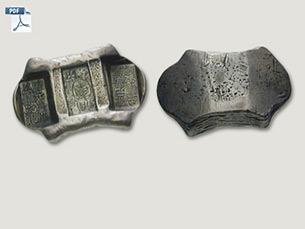Chinese Silver Ingots

A peculiarity of Chinese monetary history was the almost complete absence of coins made of precious metals, whether of gold or silver. For over 2,000 years, copper coins dominated the monetary scene in China. Although the Chinese invented paper money at an early date, partly for the very reason that copper coins were inconvenient for large transactions, the people's confidence in paper money was limited. Thus it came about that the most constant measure of value was silver, in the form of silver ingots.
The use of silver ingots as a currency goes back 2,000 years: the Han Emperor Wu Di is said to have used silver ingots as a means of payment. However, hardly any examples of silver ingots of that date have survived, because they were repeatedly melted down and recast. From the 7th century AD, silver gained in importance in everyday transactions. The ingots were used in trading, and became more widespread among the people at large as a means of paying dues and taxes. Silver ingots were also used to back the paper money. Their issue was controlled by private people – tradesmen, merchants, bankers.